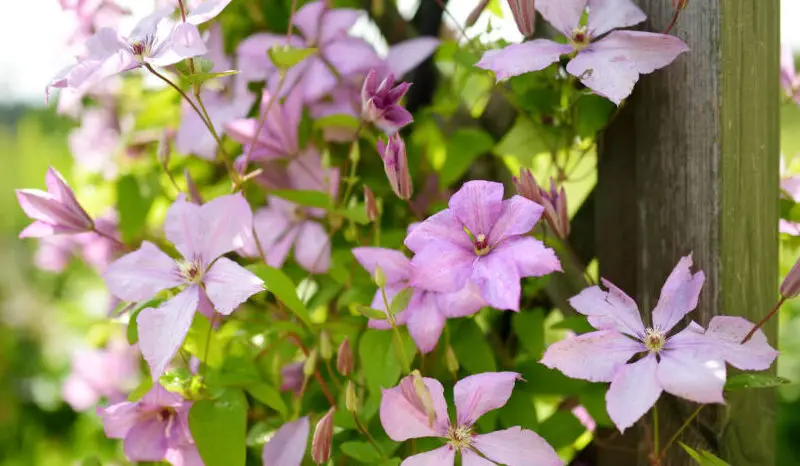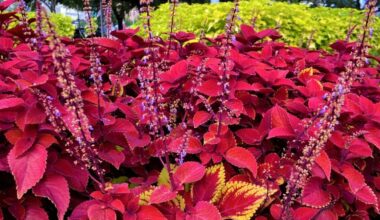Clematis is planted in the fall or spring, outside of frost periods, in a mixture of garden soil and topsoil.
Ideally, the plant should remain in the shade. Planting other flowers around the foot will keep it cool. If the plant is exposed to sunlight, cover it with a tile or a few stones, for example.
Clematis plants appreciate fresh, drained and rich soil. It can be clayey, sandy or humusy, but preferably not calcareous.
Contents
What exposure for a Clematite in clay soil
Plant the clematis in the sun, but the foot in the shade (shade the foot of the plant with some tiles, low vegetation…). Varieties with very large flowers, however, prefer a semi-shaded situation.
Planting Clematis in a clay soil
Clematis can be planted in any season, the ideal being spring or autumn. Avoid periods of frost in winter and high temperatures in summer. When planting, and especially if your soil is clay, place a drainage layer (gravel, etc.) at the bottom of the planting hole.
Incorporate compost or compost and add organic fertilizer if necessary. Take care to incline the root ball in the planting hole, towards the support, and bury the base of the stems under about ten centimetres.
Finally, don’t forget to mulch the soil: this will ensure a cool soil during the summer and will limit watering. If you plant your clematis at the foot of an already well established plant, count 20 inches between the two feet.
Characteristics of a clay soil
In geology, the minerals in a rock that measure less than 2 µm (micrometers) are called “clay”. Clay soil is therefore composed of a large number of tiny rock particles. For this reason, clay soil is extremely heavy and compact:
- It hardly allows water to pass through:
- In times of drought, it becomes very hard and can crack. Rehydration is then long and difficult.
- In wet weather, water tends to accumulate on the surface of the soil, making it muddy and sticky.
- Having a clay soil is both an asset and a constraint:
- Indeed, because of its richness in minerals, the clay soil is very fertile and allows the cultivation of many plants.
- On the other hand, its impermeable and dense character makes it relatively difficult to work.
Maintaining Clematis in Clay Soil
The maintenance of clematis in clay soil is quite simple. Once they are well installed, they are satisfied with a complete fertilizer supply each year in spring (not indispensable if the soil is naturally rich) and with an indispensable pruning.
Water in dry weather during the summer, as clematis thrives in relatively cool, clayey soil. But beware: moisture causes the stems to rot, so water at 20 inches from the foot and not directly at the foot of the clematis.
Clematis Pruning
The pruning of the clematis is essential for their flowering. It is carried out after flowering before the start of the vegetation and will encourage the formation of new shoots. According to the category to which the clematis belongs, one will apply a so-called radical pruning or a so-called selective pruning.
The radical pruning concerns herbaceous clematis and woody plants with summer flowering. It is carried out in February and March. It consists in cutting the tuft at 16 inches above the ground.
Selective pruning concerns woody clematis that bloom in April-June and those that bloom twice a year. It involves cutting dead, weak, hail or old stems. If you hesitate, cut one stem out of two, keeping the younger one.
Attacks and Diseases of Clematis in Clay Soil
Clematis wilt is a disease of its own. It is caused by a fungus: Ascichyta clematidae that blocks the flow of sap in the plant. Desiccation is inevitable and brutal.
If the soil is contaminated, it is useless to replant a clematis without sterilizing it to get rid of the fungus. To avoid this kind of problem, it is at the time of planting that everything comes into play: the use of a healthy soil and the respect of the clematis requirements.
Bacillus caulivorus is responsible for the “black disease”. It also causes the more or less brutal fanaticism of the plant, it attacks especially the hybrid clematis with large flowers. The solution ? “We cut everything and we start again”, the stems are cut at ground level and the plant goes back to vegetation.
How to use Clematis
Wall decoration
Clematis is a climbing plant that needs a support to flourish. It does not have like spike ivy, it is the petiole of its leaf that rolls up and clings to its support. If we want it to decorate a wall, we will think of installing a wooden or metal trellis, 4 inches from the wall to let the air circulate.
It can also be mounted on a fence, a tree, a shrub or a hedge. It will be perfect to decorate a large pergola, an embankment or a pylon. By its rapid development, clematis will quickly cover its support. It is not a plant excluded from the balconies, because it holds well in tubs where it will be necessary, as in the garden, to trellis it on a trellis.
Think of marrying clematis to climbing roses, the many colors offered by horticulture will allow you to compose the most charming romantic picture.
Climbing or herbaceous
Among the climbers, one distinguishes clematis with small flowers (1 to 2 inches in diameter) from clematis with large flowers (4 to 8 inches in diameter). The latter offer the widest choice of colors such as ‘The President’, the most famous variety, with large dark purple spring flowers.
There are also so-called herbaceous clematis, which are sometimes used as perennials in rock gardens and mixed borders. They are very flowering in late summer. Some, like the hybrids of Clematis viticella, are perfect for a free use in garland.
Summary
Clematis are charming climbing plants: easy to live with, resistant, they flower generously and are perfect to dress a fence, a wall or an old tree. We explain how to plant and maintain them in clay soil.









